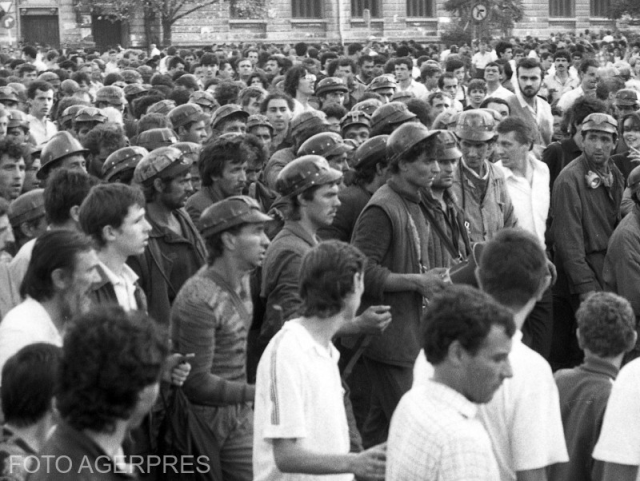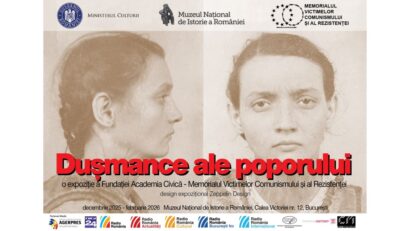Miners’ riots in the early 1990s
Miners' riots, thirty years on

Steliu Lambru, 15.06.2020, 14:00
The
violent outbursts of June 13-15, 1990, having miners’ arrival in Bucharest as
their momentum as well as the miners’ lashing out at Romanian capital city’s
civilian population meant that Romanian society was backtracking on democracy,
within six months since Romanians had regained their freedom in December 1989.
The events back then proved that a society that had freshly emerged from a
totalitarian political regime still had the demons of the past to fight before
it healed completely. In June 1990, it was for the third time that Bucharest
had been stormed by the miners, in a bid to back the then National Salvation
Front against opposition parties. Among other things, miners’ riots were in
fact a manifestation of hatred and intolerance against democratic pluralism
which at that time was very difficult to become functional in Romania. Against
the backdrop of the protest rallies mounted by the Opposition in April 1990 and
in the aftermath of the election held on May 20, 1990, won by the National
Salvation Front, tension was literally spiraling. On June 30, 1990, the state
institutions tried to quash the protest rallies in University Square, which was
the beginning of three-day long violent clashes that eventually claimed the
lives of 6 people, leaving 750 other wounded.
What
happened over June 13-15 was a one-of-a-kind event. The historian Cristian Vasile told us what was so very unique about that
event.
Some of the historians placed it against the backdrop of the time span
that occurred immediately after communism in Romania, describing it as the last
repression of a communist origin ever to have been staged in the country. And
they are right, I think, because manifestations back then, consisting in the
reprisal of part of the civilian population, have certain points in common with
what happened in national history immediately after 1944. An explanation of
that could be the fact that the political staff and political practices of
March, 1945, continued even after that date. The common political practice of instigating
civilians against one another was also implemented in June 1990.
It has
been said that miners’ riots of June 1990 were made possible by the state
institutions being weak, by the riot police failing to quash protest rallies on
June 13.
Historian Cristian Vasile:
I also tend to believe in the theory of the riot police being weak and
unable to contain certain forms of popular unrest. If we have a closer look at
how things developed over June 13 and 15, mostly on June 13 as that is the
climactic day, we can indeed see the riot police slackening, but there are also
a couple of issues that have been hitherto unexplained. There are several recordings,
real recordings, there are those radio interventions of then the deputy
Interior Minister, general Diamandescu, who said something like we are going
to set the buses ablaze, as agreed, to the recipient of his messages. What are
we to make of that kind of exchange? Then there are concordant testimonies
whereby there were not the rioters who set fire on the police building in the
capital city, but the building was set ablaze from the inside. Also unexplained is how hundreds of policemen retreated with no defense, leaving
the Interior Ministry building also unprotected.
The
new power embodied by Ion Iliescu had to be strengthened through the
manipulation of the crowds, so most of those who analyzed miners’ riots view
that as a meaningful explanation of events back then.
Historian Cristian Vasile:
The unrest that flared up in University Square and Victoria Road was
quashed around midnight on the night to of June 13 and all through to 3 am, on June
14. Riot police managed to have everything under control, rioters had been
arrested. The miners came a little bit later, they were welcomed by the then
president Ion Iliescu. Instead of defusing the tension, telling the miners the
army and the police had everything under control, Ion Iliescu invited them to
occupy University Square. What was the purpose of such a move, since a couple
of hours earlier the police and the army totally controlled the situation? That
utterly reckless invitation led to the violent clashes that broke out on June
14, in the morning, and on the following day. So all in all, it was an
absolutely pointless instigation to violence, a criminal act which was worthy
of the Criminal Code.
The miners’ riots of June 1990 were one last
convulsion of the communist mindset, in a society that had but newly emerged
from the collapse of the communist regime in December 1989.
Cristian Vasile:
Why the miners? Attempts were made with other categories of workers,
even over June 13 and 14. There is official evidence of a call being made for
workers from Bucharest, of several factories and plants, of the August 23 Plants
and suchlike. Quite a few of the unions turned down the proposal and refused to
intervene, on the grounds that the conflict was of a political nature and it
was not for them to set things to rights. Yet it appears that the miners as a
category were more receptive to the propaganda of the then National Salvation
Front, of Iliescu’s regime. As for Ion Iliescu, he has been defending himself
claiming he did not make his call to the miners alone, but to all responsible
social forces. But that is an aggravating circumstance for somebody who is the
president of a country. And it is here that the tragedy of those episode lies,
there was the buoyancy of part of the Bucharest population who literally gave
miners rounds of applause for what they were doing. And what they did was to
beat young students to a pulp, as well as bearded men or women wearing
mini-skirts. Which was a stark reminder of Ceausescu’s policy, of rockers being
hunted in the 1970s.
The
price Romania had to pay for miners’ riots of June 13-15, 1990, was its own
international isolation. Specifically, that meant the agreement with the IMF
being frozen, but also the impossibility to contract another loan.
Politically, miners’ riots of June 1990 stalled Romania’s gaining accession to
the Council of Europe. It was not until 1993 that Romania became a member of
the Council of Europe, much later than many other countries of the former
Soviet Bloc.
(Translation by Eugen Nasta)






























